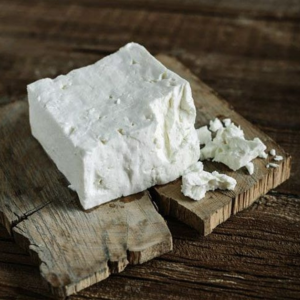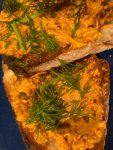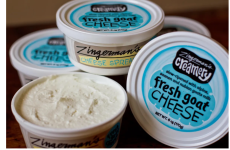Greek Sheep’s Milk Feta at the Cream Top Shop
Handmade artisan feta from the island of Lesbos
As you probably know by now, I’m a big fan of feta cheese. This new arrival is amazing! To be clear, I still, also, love the Mt. Vikos-brand, barrel-aged feta we get from Vassily Roussas in northern Greece that we stock regularly at the Deli. It’s made with a blend of goat and sheep’s milk. It’s a bit firmer than this one from Lesbos, not quite as creamy, maybe a slight bit less salt. But I learned a long time ago that any good cheese shop in Greece will offer up to half a dozen different feta cheeses. Greek cheese eaters are as aware of regional feta flavors as Frenchmen are of the flavors of local wines. Different milk, different plants in the pastures, different starter cultures. “Each serious cheesemaker has his own,” Vasili Roussas told me years ago.
This new arrival from Lesbos proves his point. Both cheeses are excellent, each has its own distinctive feta-flavor and character. Like every other traditional cheese, feta should change according to the style and soil of the region in which it was made. The feta from Lesbos has hints in the milk of armirikia, a rare herb that grows on the island. The cheese is exceptionally creamy in texture, complex in flavor with an almost-vanilla-like finish.

Lesbos is one of the easternmost Greek islands—it lies just west off the coast of Turkey, near Izmir and about halfway as the crow would fly from Athens to Istanbul. It’s been ruled by any number of royal families and governments—Byzantium, Genoa, the Turkish sultans to name a few. Lesbos became a part of the Republic of Greece back in 1912. It’s known as the home of the goddess Sappho, hence its use in the word Lesbian. Agra, the small village where the cheese is made, is located on the western end of the island. The shepherds work collectively and bring the milk to the Tastanis family to turn into cheese. It’s made only when the sheep are out in the pastures—roughly December through July (breeding takes place after that—the sheep, like most everyone in Greece, take August “off”). The Lesbos feta is a 100 percent sheep milk (hence also higher in cost since sheep yield by far the lowest of any milking animal). The Tastanis use sea salt from the traditional sources at Kalloni on the southern shore of the island, which adds to the quality of the cheese.
It’s great for Greek salad and wonderful in that watermelon salad I just wrote about a few weeks ago. It’s also excellent in the Egyptian Cucumber and Feta salad I wrote up back in July. The feta is a great pairing with some of the Greek wildflower honey. You can add it to pasta; bake it with beans; crumble some over just-cooked potatoes dressed with olive oil, salt, and pepper. Put it on burgers or crumble onto bean soups. Rachel Juhl, who helps get the cheese imported, shared her favorite feta tip: “My very non-Greek favorite way to eat it is to fry thick-cut Benton’s bacon in a pan, once you flip it add two farm fresh fried eggs and chopped Toscano kale to the grease in the pan (push bacon to the side) and put the feta on the kale. Once the bacon is done, serve all together, and BAM.”
A percentage of the proceeds from the Lesbos feta go to the Daphne Zepos Teaching Award—before she died in 2012, Daphne was a partner in the importing company Essex Cheese (along with Zingerman’s Mail Order’s own Mo Frechette and Neal’s Yard Dairy’s Jason Hinds). One of Daphne’s great passions was to spread the word about the barely-known cheeses of Greece. Feta was well known, but in the U.S. it has typically been about as inauthentic as the wild rice I wrote about last week. Most had nothing to do with the authentic article. This lovely pure sheep feta from Lesbos (along with the Mt. Vikos feta at the Deli) fills that bill of authenticity. I feel confident it would have made Daphne happy to know that we have it.




Zingerman’s Art for Sale